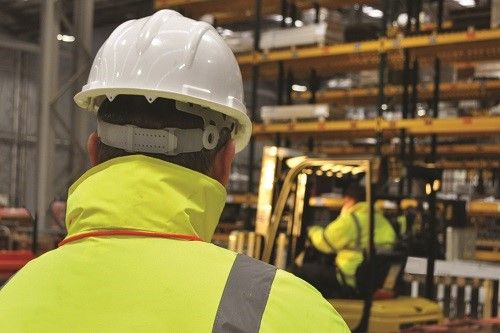Forklift Safety: Don't Blame The Machine
October 2018
As Safetember, the Fork Lift Truck Association’s annual forklift safety awareness campaign, drew to a close, it is time to discuss the challenges facing those responsible for ensuring safe operations.
No-one ever plans to have an accident, but the reality is that accidents can and do happen.
Forklift trucks are central to logistics operations, but the associated risks are high – particularly for those working alongside them.
 Photograph: FLTA
Photograph: FLTAEvery working day, five lives are changed – in an instant – because of injuries resulting from accidents involving forklift trucks. You only need to take a cursory look over the HSE’s forklift accident figures to see how serious the problem is.
The most recent accident statistics show forklifts are officially the most dangerous form of workplace transport in the country: injuring more people than Heavy Goods Vehicles (HGV) or Large Goods Vehicle (LGV). In fact, 25% of workplace transport injuries are a direct result of forklift truck accidents.
Around 1,300 UK employees are hospitalised each year with serious injuries following forklift accidents, and that number is rising. That’s five UK workers each workday suffering debilitating and life-changing injuries, including complex fractures, dislocations, de-gloving’s and amputations.
Insufficient segregation between forklifts and pedestrians is a common problem.
The Human Cost
The size and nature of forklift trucks means that accidents are often life-changing or even fatal. With a forklift, there are no minor injuries. In short, you don’t walk away from a forklift accident.
The resulting injuries can devastate the lives of not just the injured, but their colleagues, friends and families. All those lives can be changed in an instant.
The danger doesn’t just come from the trucks themselves. Operator error means that pedestrians working around counterbalance and reach trucks run the risk of crush injuries from falling loads.
Even smaller mastless vehicles like power pallet trucks (PPT) can cause serious injuries. Every year, hundreds of workers suffer lower body injuries as a result of accidents. Their smaller size can make employers complacent about the need to provide operators proper training. This complacent attitude often extends to operators and pedestrians too.
Your Responsibilities
The number of company directors and senior managers prosecuted under health and safety law has risen significantly in recent years – reaching a six-year high in 2015/16.
With three in four of these directors successfully prosecuted, the message from HSE is strong and clear: health and safety violations will be taken very seriously, and no one is above the law.
Those in charge are responsible for their workforce and are being held accountable when violations occur.
Even if those ‘at the top’ are unaware of issues they are legally obligated to address, there’s a legal precedent in place that would declare directors liable.
The responsibility breaks down like this: even if a forklift driver is directly responsible for a violation, there’s a good chance that there was something their supervisor could have and should have spotted beforehand. But, if that supervisor hadn’t received adequate training on what to look out for, then there’s a strong argument for the liability going up the chain of command.
As those leading the operation, managers need to take ownership of site safety. While you don’t need to be able to operate a forklift yourself, it’s important that managers and supervisors understand the operation and the associated hazards the workforce is facing.
“Operator training is vital, but if your managers and supervisors haven’t got the skills and knowledge to ensure best practice is being followed, there’s a dangerous flaw in your operations.
“As a manager, you play a huge role in influencing site culture. Where risk is so high, it’s important that your staff feel able to speak out when they see unsafe practice. A culture of silence is dangerous. By empowering your workers to take ownership and speak up when they see bad practice, you can create a safer site.”
HSE’S Approved Code of Practice on the provision of training for operators of rider operated fork lift trucks known as (L117), states that training should consist of three stages. These are:
-·Basic training on how to safely operate the relevant type of lift truck, delivered by a suitably trained instructor., and including appropriate practical and theoretical tests of the trainee’s skills and knowledge.
- Specific job training tailored to the employer’s needs, such as the conditions the employee will encounter in the workplace.
- Familiarisation training, which must be carried out on the job and involves applying and practising the skills learned under normal working conditions and becoming familiar with other relevant factors such as the specific site layout.
HSE adds that even fully trained and experienced lift truck operators should be routinely monitored at work and, where necessary, re-tested or provided with refresher training to ensure they continue to operate lift trucks safely.
For more information regarding RTITB and our in-house Training Courses, please contact Alliance Learning on 01204 677811 or Click Here to download our Course Schedule.
